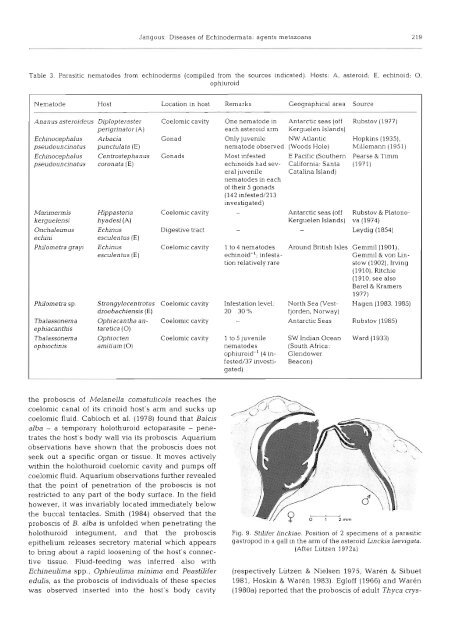Diseases of Echinodermata. 11. Agents metazoans ... - Inter Research
Diseases of Echinodermata. 11. Agents metazoans ... - Inter Research
Diseases of Echinodermata. 11. Agents metazoans ... - Inter Research
Create successful ePaper yourself
Turn your PDF publications into a flip-book with our unique Google optimized e-Paper software.
Jangoux: <strong>Diseases</strong> <strong>of</strong> <strong>Echinodermata</strong>: agents <strong>metazoans</strong> 219<br />
Table 3. Parasitic nematodes from echinoderms (compiled from the sources indicated). Hosts: A, asteroid; E, echinoid; 0,<br />
ophiuroid<br />
Nematode Host Location in host Remarks Geographical area Source<br />
Ananus asteroideus Diplopteraster Coelomic cavity One nematode in Antarctic seas (<strong>of</strong>f Rubstov (1977)<br />
perigrinator (A) each asteroid arm Kerguelen Islands)<br />
Echjnocephalus Arbacia Gonad Only juvenile NW Atlantic Hopkins (l935),<br />
pseudouncinatus punctulata (E) nematode observed (Woods Hole) Mlllemann (1951)<br />
Echinocephalus Centrostephanus Gonads Most infested E Pacific (Southern Pearse & Timm<br />
pseudouncinatus coronata (E) echino~ds had sev- California: Santa (1971)<br />
era1 juvenile<br />
nematodes in each<br />
<strong>of</strong> their 5 gonads<br />
(142 infested/213<br />
investigated)<br />
Catalina Island)<br />
Antarctic seas (<strong>of</strong>f Rubstov & Platono<br />
Kerguelen Islands) va (1974)<br />
- Leydig (1854)<br />
Marim ermis Hippas feria Coelomic cavity -<br />
kerguelensi hyadesi (A)<br />
Onchaleimus Echinus Digestive tract -<br />
echini esculentus (E)<br />
Phllometra grayi Echin us Coelomic cavity 1 to 4 nematodes Around British Isles Gemmil (1901),<br />
esculentus (E) echinoid-'; infesta- Gemmil & von Lintion<br />
relatively rare stow (1902), Irving<br />
(1910), Ritchie<br />
(1910, see also<br />
Bare1 & Kramers<br />
1977)<br />
Philometra sp. Strongylocentrotus Coelomic cavity Infestation level: North Sea (Vest- Hagen [l 983, 1985)<br />
droebachiensis (E) 20 30% fjorden, Norway)<br />
Thalassonema Ophiacantha an- Coelomic cavity - Antarctic Seas Rubstov (1985)<br />
ephiacan this taretica (0)<br />
Thalassonema Ophiocten Coelomic cavity 1 to 5 juvenile SW Indian Ocean Ward (1933)<br />
ophioctinis arnitium (0) nematodes (South Africa:<br />
ophiuroid-' (4 in- Glendower<br />
fested/37 investigated)<br />
Beacon)<br />
the proboscis <strong>of</strong> Melanella comatulicola reaches the<br />
coelomic canal <strong>of</strong> its crinoid host's arm and sucks up<br />
coelomic fluid. Cabioch et al. (1978) found that Balcis<br />
alba - a temporary holothuroid ectoparasite - penetrates<br />
the host's body wall via its proboscis. Aquarium<br />
observations have shown that the proboscis does not<br />
seek out a specific organ or tissue. It moves actively<br />
within the holothuroid coelomic cavity and pumps <strong>of</strong>f<br />
coelomic fluid. Aquarium observations further revealed<br />
that the point <strong>of</strong> penetration <strong>of</strong> the proboscis is not<br />
restricted to any part <strong>of</strong> the body surface. In the field<br />
however, it was invariably located immediately below<br />
the buccal tentacles. Smith (1984) observed that the<br />
proboscis <strong>of</strong> B. alba is unfolded when penetrating the<br />
-L<br />
0 1 2mm<br />
holothuroid integument, and that the proboscis Fig. 9. StiD'fer linckiae. Position <strong>of</strong> 2 specimens <strong>of</strong> a parasitic<br />
epithelium releases secretory material which appears gastropod in a gall in the arm <strong>of</strong> the asteroid L~nclua laevigata.<br />
to bring about a rapid loosening <strong>of</strong> the host's connective<br />
tissue. Fluid-feeding was inferred also with<br />
(After Liitzen 1972a)<br />
EchineuLima spp., OphieuLima minima and Peastilifer (respectively Liitzen & Nielsen 1975, Waren & Sibuet<br />
eduljs, as the proboscis <strong>of</strong> individuals <strong>of</strong> these species 1981, Hoskin & Waren 1983). Egl<strong>of</strong>f (1966) and Waren<br />
was observed inserted into the host's body cavity (1980a) reported that the proboscis <strong>of</strong> adult Thyca crys-

















